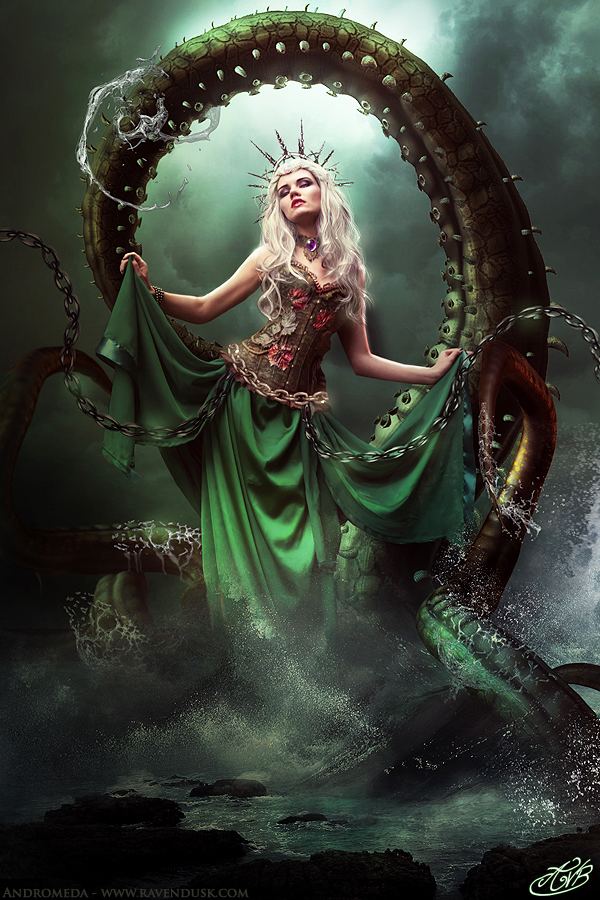 | ||
Movies Clash of the Titans, Wrath of the Titans Played by Rosamund Pike, Alexa Davalos, Judi Bowker Similar | ||
In Greek mythology, Andromeda is the daughter of the Aethiopian king Cepheus and his wife Cassiopeia. When Cassiopeia's hubris leads her to boast that Andromeda is more beautiful than the Nereids, Poseidon sends the sea monster Cetus to ravage Aethiopia as divine punishment. Andromeda is stripped and chained naked to a rock as a sacrifice to sate the monster, but is saved from death by Perseus.
Contents
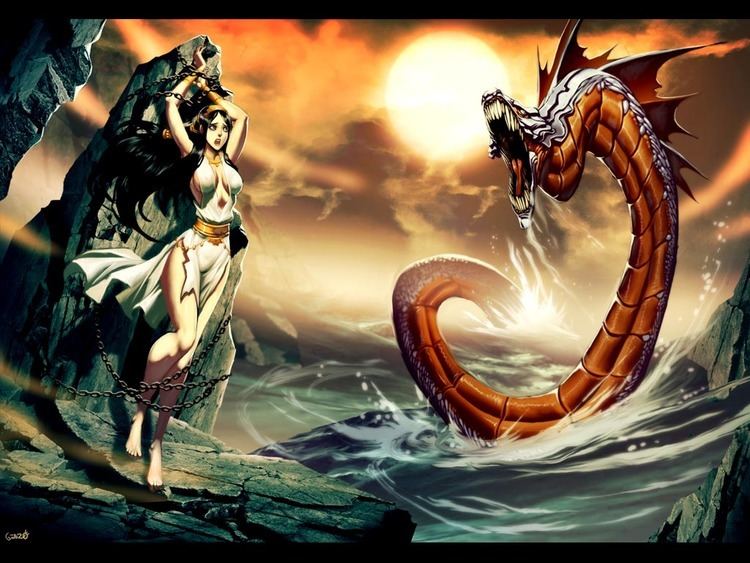
Her name is the Latinized form of the Greek Ἀνδρομέδα (Androméda) or Ἀνδρομέδη (Andromédē): "ruler of men", from ἀνήρ, ἀνδρός (anēr, andrós) "man", and medon, "ruler".

As a subject, Andromeda has been popular in art since classical times; it is one of several Greek myths of a Greek hero's rescue of the intended victim of an archaic hieros gamos (sacred marriage), giving rise to the "princess and dragon" motif. From the Renaissance, interest revived in the original story, typically as derived from Ovid's account.
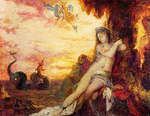
Mythology
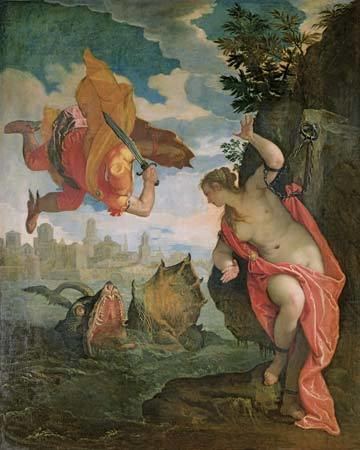
In Greek mythology, Andromeda was the daughter of Cepheus and Cassiopeia, king and queen of the North African kingdom of Aethiopia.
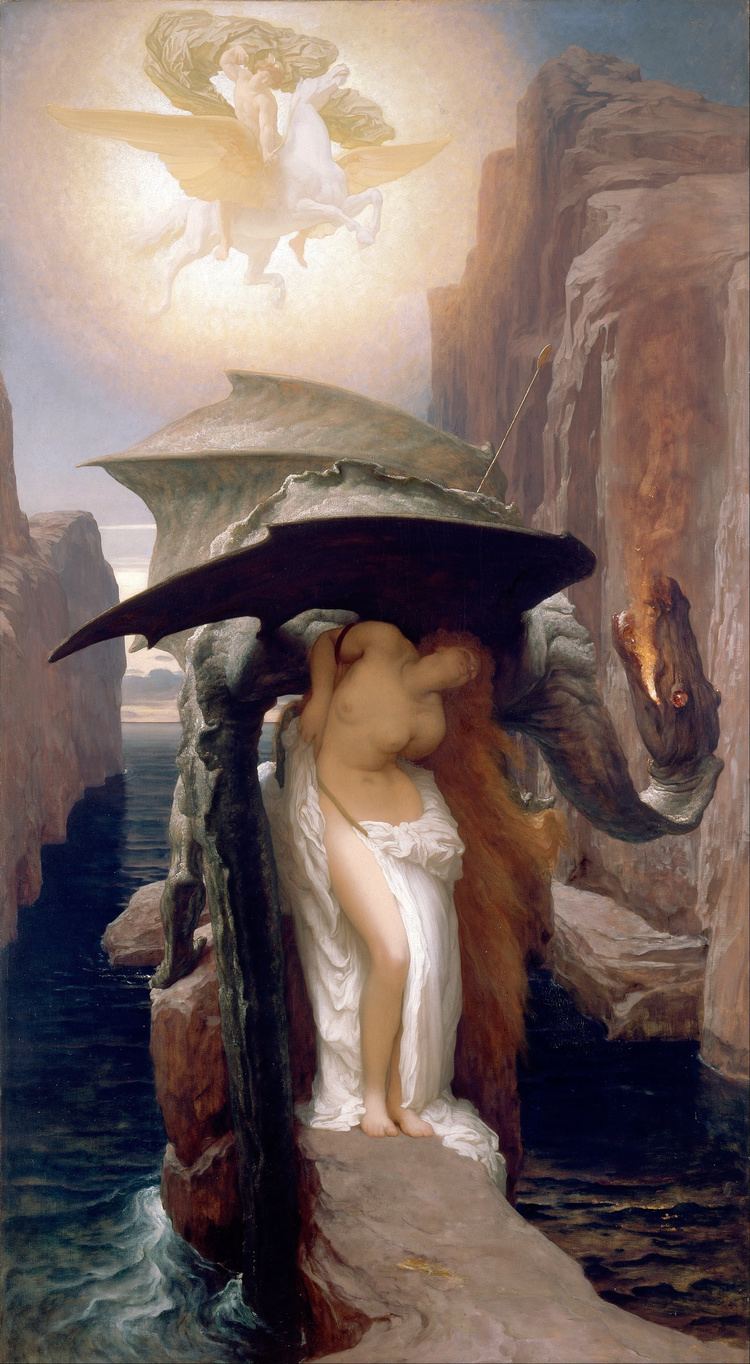
Her mother Cassiopeia boasted that her daughter was more beautiful than the Nereids, the nymph-daughters of the sea god Nereus and often seen accompanying Poseidon. To punish the queen for her arrogance, Poseidon, brother to Zeus and god of the sea, sent a sea monster named Cetus to ravage the coast of Aethiopia including the kingdom of the vain queen. The desperate king consulted the Oracle of Apollo, who announced that no respite would be found until the king sacrificed his daughter, Andromeda, to the monster. Stripped naked, she was chained to a rock on the coast.
Perseus was returning from having slain the Gorgon Medusa. After he happened upon the chained Andromeda, he approached Cetus while invisible (for he was wearing Hades's helm), and killed the sea monster. He set Andromeda free, and married her in spite of her having been previously promised to her uncle Phineus. At the wedding a quarrel took place between the rivals and Phineus was turned to stone by the sight of the Gorgon's head.
Andromeda followed her husband, first to his native island of Serifos, where he rescued his mother Danaë, and then to Tiryns in Argos. Together, they became the ancestors of the family of the Perseidae through the line of their son Perses. Perseus and Andromeda had seven sons: Perses, Alcaeus, Heleus, Mestor, Sthenelus, Electryon, and Cynurus as well as two daughters, Autochthe and Gorgophone. Their descendants ruled Mycenae from Electryon down to Eurystheus, after whom Atreus attained the kingdom, and would also include the great hero Heracles. According to this mythology, Perseus is the ancestor of the Persians.
At the port city of Jaffa (today part of Tel Aviv) an outcrop of rocks near the harbour has been associated with the place of Andromeda's chaining and rescue by the traveler Pausanias, the geographer Strabo and the historian of the Jews Josephus.
After Andromeda's death, as Euripides had promised Athena at the end of his Andromeda, produced in 412 BCE, the goddess placed her among the constellations in the northern sky, near Perseus and Cassiopeia; the constellation Andromeda, so known since antiquity, is named after her.
Constellations
Andromeda is represented in the northern sky by the constellation Andromeda, which contains the Andromeda Galaxy.
The advancement of science and technology allowed the emergence of astrophotography which allowed more concrete observation of the Andromeda constellation and lead to the discovery that the galaxy lies within the Andromeda constellation.
Four constellations are associated with the myth. Viewing the fainter stars visible to the naked eye, the constellations are rendered as:
Other constellations related to the story are:
Perseus and Andromeda in art
Sophocles and Euripides (and in more modern times, Corneille) made the story the subject of tragedies, and its incidents were represented in numerous ancient works of art, including Greek vases. Jean-Baptiste Lully's opera, Persée, also dramatizes the myth.
Andromeda has been the subject of numerous ancient and modern works of art, which typically show the moment of rescue, with Andromeda usually still chained, and often naked or nearly so. Examples include: one of Titian's poesies (Wallace Collection), and compositions by Joachim Wtewael (Louvre), Veronese (Rennes), many versions by Rubens, Ingres, and Gustave Moreau. From the Renaissance onward the chained nude figure of Andromeda typically was the centre of interest. Rembrandt's Andromeda Chained to the Rocks is unusual in showing her alone, fearfully awaiting the monster.
The Italian composer Salvatore Sciarrino composed an hour-long operatic drama called Perseo e Andromeda in 2000.
